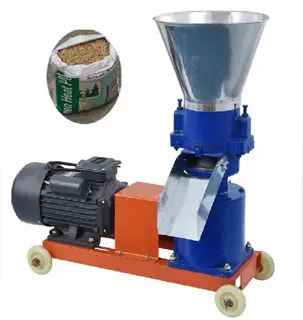
In the realm of modern manufacturing and sustainable energy solutions, pellets have emerged as a versatile and eco-friendly option. These compacted forms of raw materials serve various industries, from fuel to animal feed production. In this article, we’ll delve into the essential raw materials used for pellet production, shedding light on their significance and the process involved.
Understanding Raw Materials for Pellet Production
Pellet Machine Manufacturers production involves the transformation of raw materials into small, cylindrical shapes that offer convenient handling, storage, and usage. The choice of raw materials significantly influences the quality and characteristics of the resulting pellets. Here, we’ll explore some common raw materials used in pellet production and their roles:
- Biomass Residues: Biomass residues, such as agricultural crop waste, wood chips, sawdust, and wood shavings, form a major category of raw materials for pellets. These materials are abundant, renewable, and have gained attention for their potential to replace fossil fuels. Wood sawdust, for instance, serves as an excellent feedstock due to its high lignocellulosic content.
- Crop Byproducts: Agricultural residues like corn stover, rice husks, and wheat straw also play a vital role in pellet production. These materials are often considered waste but can be repurposed into valuable pellets. Crop byproducts are rich in cellulose and can be processed to create pellets suitable for various applications.
- Animal Wastes: Organic materials such as cow dung are increasingly utilized in pellet production. These materials are processed to remove moisture and then compressed into pellets. The resulting pellets can serve as biofertilizers or fuel sources, contributing to sustainable waste management.
The Pellet Production Process
Creating pellets involves a series of steps, including material preparation, grinding, drying, pelletizing, and cooling. During this process, specialized machinery is crucial to ensure efficient production. Notably, companies like Keyul Enterprise have played a pivotal role in manufacturing a range of machines essential to this process, such as cattle feed making machines, Hammer Mill Manufacturers, oil presses, Oil Filter Manufacturers, wood chippers, Chaff Cutter Machine Manufacturers, Cow Dung Dewatering Machine Manufacturers, and wood sawdust machines.
Keyul Enterprise: Driving Pellet Production Innovation
Keyul Enterprise, a prominent name in the industry, has been dedicated to manufacturing top-notch machinery for pellet production and more. With a diverse range of offerings including cattle feed making machine and hammer mills, they have proven their expertise in enhancing the efficiency of the pelletization process. Moreover, their Oil Press Manufacturers, oil filters, and Wood Chipper Manufacturers cater to various industries, supporting sustainable practices.
Conclusion
In conclusion, the raw materials used for pellet production are varied and abundant, ranging from biomass residues to crop byproducts and animal wastes. These materials, when processed with precision and expertise, result in high-quality pellets with diverse applications. As the demand for sustainable solutions rises, the contributions of companies like Keyul Enterprise become invaluable, providing the necessary machinery to drive innovation in pellet production and related industries.
FQA’s
Q: What are pellets made from?
A: Pellets are made from a variety of raw materials, including biomass residues such as wood chips, sawdust, and agricultural crop waste. Crop byproducts like rice husks and wheat straw, as well as organic materials such as cow dung, are also commonly used.
Q: Why are biomass residues popular as pellet raw materials?
A: Biomass residues offer several advantages as raw materials for pellets. They are abundant, renewable, and often considered waste. These materials have high lignocellulosic content, making them suitable for pelletization and offering a sustainable alternative to fossil fuels.
Q: How are crop byproducts transformed into pellets?
A: Crop byproducts like corn stover and wheat straw can be processed by grinding, drying, and pelletizing. The cellulose-rich content of these materials makes them suitable for pellet production, reducing waste and providing an eco-friendly solution.
Q: What role do animal wastes play in pellet production?
A: Animal wastes, such as cow dung, can be processed into pellets after dewatering and drying. These pellets can serve as biofertilizers or fuel sources, contributing to effective waste management and sustainable practices.
Q: What is the significance of machinery in pellet production?
A: Specialized machinery is essential for efficient pellet production. Machines like cattle feed making machines, hammer mills, and wood chippers play a crucial role in preparing and processing raw materials, ensuring consistent quality in the final pellets.
Q: How does Keyul Enterprise contribute to pellet production?
A: Keyul Enterprise is a reputable manufacturer of machinery related to pellet production. They offer a diverse range of equipment, including cattle feed making machines, hammer mills, oil presses, oil filters, wood chippers, and more, supporting industries that prioritize sustainability and innovation.
Q: Can pellet production help reduce waste and promote sustainability?
A: Yes, pellet production contributes to waste reduction by repurposing agricultural and organic residues that would otherwise go to waste. By using these materials to create valuable pellets, industries can embrace more sustainable practices and reduce their environmental impact.
Q: Are there any challenges associated with using raw materials for pellet production?
A: While using raw materials for pellets is environmentally beneficial, challenges such as consistent availability of biomass residues and the need for efficient processing methods need to be addressed for sustainable and scalable production.
Q: What are the main applications of pellets made from different raw materials?
A: Pellets produced from various raw materials find applications in sectors like energy production, animal feed, and fertilization. Biomass pellets can be used as a renewable energy source, while animal waste pellets contribute to organic farming practices and waste management.
Q: How can industries ensure the quality of pellets made from diverse raw materials?
A: To ensure pellet quality, industries need to follow proper processing methods, including material preparation, grinding, and pelletizing. The use of high-quality machinery, such as those provided by Keyul Enterprise, can significantly enhance the consistency and quality of the final pellets.
Stay connected to Navigating Licensing Requirements for Cattle Feed Manufacturing to know more about such interesting facts!